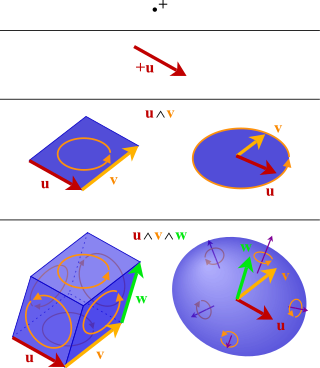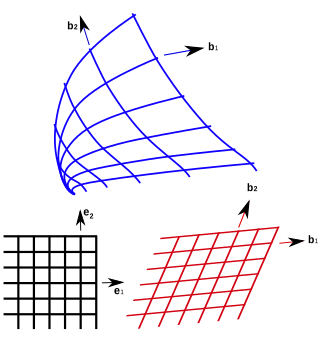
In vector calculus, divergence is a vector operator that operates on a vector field, producing a scalar field giving the quantity of the vector field's source at each point. More technically, the divergence represents the volume density of the outward flux of a vector field from an infinitesimal volume around a given point.

In mathematical physics and mathematics, the Pauli matrices are a set of three 2 × 2 complex matrices which are Hermitian, involutory and unitary. Usually indicated by the Greek letter sigma, they are occasionally denoted by tau when used in connection with isospin symmetries.
In mathematics, a product is the result of multiplication, or an expression that identifies objects to be multiplied, called factors. For example, 30 is the product of 6 and 5, and is the product of and .

In mathematics, a tensor is an algebraic object that describes a multilinear relationship between sets of algebraic objects related to a vector space. Tensors may map between different objects such as vectors, scalars, and even other tensors. There are many types of tensors, including scalars and vectors, dual vectors, multilinear maps between vector spaces, and even some operations such as the dot product. Tensors are defined independent of any basis, although they are often referred to by their components in a basis related to a particular coordinate system.
In category theory, a branch of mathematics, a natural transformation provides a way of transforming one functor into another while respecting the internal structure of the categories involved. Hence, a natural transformation can be considered to be a "morphism of functors". Informally, the notion of a natural transformation states that a particular map between functors can be done consistently over an entire category.
In vector calculus, the divergence theorem, also known as Gauss's theorem or Ostrogradsky's theorem, is a theorem which relates the flux of a vector field through a closed surface to the divergence of the field in the volume enclosed.

In mathematics, the orthogonal group in dimension , denoted , is the group of distance-preserving transformations of a Euclidean space of dimension that preserve a fixed point, where the group operation is given by composing transformations. The orthogonal group is sometimes called the general orthogonal group, by analogy with the general linear group. Equivalently, it is the group of orthogonal matrices, where the group operation is given by matrix multiplication. The orthogonal group is an algebraic group and a Lie group. It is compact.
In linear algebra, an n-by-n square matrix A is called invertible, if there exists an n-by-n square matrix B such that

In mathematics, the exterior algebra, or Grassmann algebra, named after Hermann Grassmann, is an algebra that uses the exterior product or wedge product as its multiplication. In mathematics, the exterior product or wedge product of vectors is an algebraic construction used in geometry to study areas, volumes, and their higher-dimensional analogues. The exterior product of two vectors and denoted by is called a bivector and lives in a space called the exterior square, a vector space that is distinct from the original space of vectors. The magnitude of can be interpreted as the area of the parallelogram with sides and which in three dimensions can also be computed using the cross product of the two vectors. More generally, all parallel plane surfaces with the same orientation and area have the same bivector as a measure of their oriented area. Like the cross product, the exterior product is anticommutative, meaning that for all vectors and but, unlike the cross product, the exterior product is associative.
In physics, an operator is a function over a space of physical states onto another space of physical states. The simplest example of the utility of operators is the study of symmetry. Because of this, they are very useful tools in classical mechanics. Operators are even more important in quantum mechanics, where they form an intrinsic part of the formulation of the theory.
In mathematics, the indefinite orthogonal group, O(p, q) is the Lie group of all linear transformations of an n-dimensional real vector space that leave invariant a nondegenerate, symmetric bilinear form of signature (p, q), where n = p + q. It is also called the pseudo-orthogonal group or generalized orthogonal group. The dimension of the group is n(n − 1)/2.

In geometry, curvilinear coordinates are a coordinate system for Euclidean space in which the coordinate lines may be curved. These coordinates may be derived from a set of Cartesian coordinates by using a transformation that is locally invertible at each point. This means that one can convert a point given in a Cartesian coordinate system to its curvilinear coordinates and back. The name curvilinear coordinates, coined by the French mathematician Lamé, derives from the fact that the coordinate surfaces of the curvilinear systems are curved.
In physics and mathematics, a pseudotensor is usually a quantity that transforms like a tensor under an orientation-preserving coordinate transformation but additionally changes sign under an orientation-reversing coordinate transformation, which is a transformation that can be expressed as a proper rotation followed by reflection. This is a generalization of a pseudovector. To evaluate a tensor or pseudotensor sign, it has to be contracted with some vectors, as many as its rank is, belonging to the space where the rotation is made while keeping the tensor coordinates unaffected. Under improper rotation a pseudotensor and a proper tensor of the same rank will have different sign which depends on the rank being even or odd. Sometimes inversion of the axes is used as an example of an improper rotation to see the behaviour of a pseudotensor, but it works only if vector space dimensions is odd otherwise inversion is a proper rotation without an additional reflection.
In mathematics, a volume element provides a means for integrating a function with respect to volume in various coordinate systems such as spherical coordinates and cylindrical coordinates. Thus a volume element is an expression of the form
In mathematics, a super vector space is a -graded vector space, that is, a vector space over a field with a given decomposition of subspaces of grade and grade . The study of super vector spaces and their generalizations is sometimes called super linear algebra. These objects find their principal application in theoretical physics where they are used to describe the various algebraic aspects of supersymmetry.
In mathematics and theoretical physics, an invariant differential operator is a kind of mathematical map from some objects to an object of similar type. These objects are typically functions on , functions on a manifold, vector valued functions, vector fields, or, more generally, sections of a vector bundle.
In algebra, the hyperdeterminant is a generalization of the determinant. Whereas a determinant is a scalar valued function defined on an n × n square matrix, a hyperdeterminant is defined on a multidimensional array of numbers or tensor. Like a determinant, the hyperdeterminant is a homogeneous polynomial with integer coefficients in the components of the tensor. Many other properties of determinants generalize in some way to hyperdeterminants, but unlike a determinant, the hyperdeterminant does not have a simple geometric interpretation in terms of volumes.
In mathematics, Capelli's identity, named after Alfredo Capelli (1887), is an analogue of the formula det(AB) = det(A) det(B), for certain matrices with noncommuting entries, related to the representation theory of the Lie algebra . It can be used to relate an invariant ƒ to the invariant Ωƒ, where Ω is Cayley's Ω process.
Curvilinear coordinates can be formulated in tensor calculus, with important applications in physics and engineering, particularly for describing transportation of physical quantities and deformation of matter in fluid mechanics and continuum mechanics.
In stochastic analysis, a rough path is a generalization of the notion of smooth path allowing to construct a robust solution theory for controlled differential equations driven by classically irregular signals, for example a Wiener process. The theory was developed in the 1990s by Terry Lyons. Several accounts of the theory are available.












